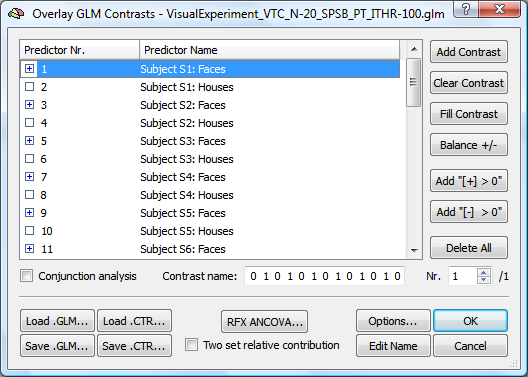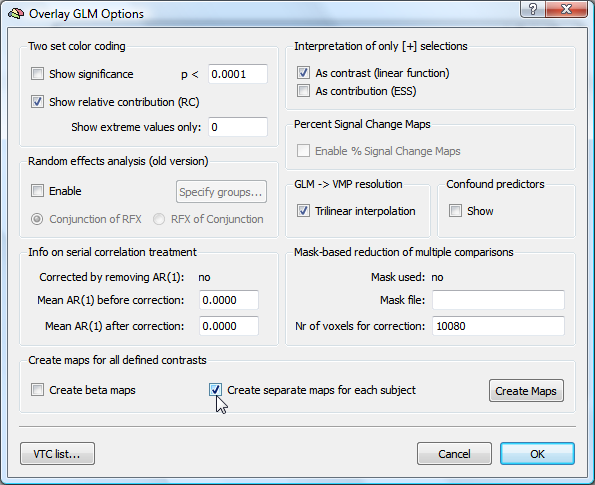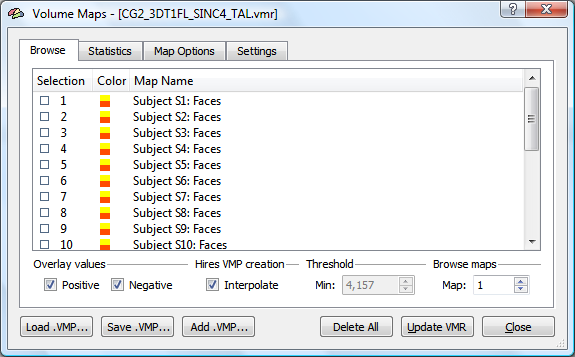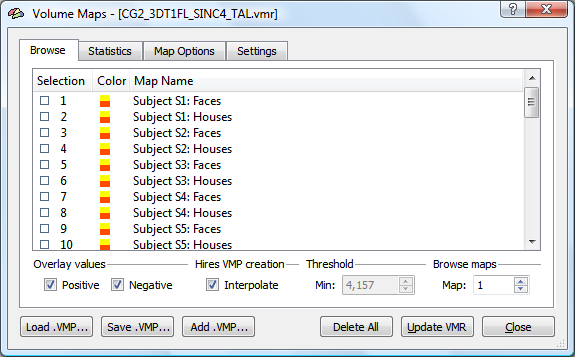BrainVoyager QX v2.8
Creating Multi-Subject t and Beta Maps from Multi-Subject GLMs
For a random effects (RFX) analysis, a data structure is required containing estimates of parameters for each condition of each subject. Since any multi-subject GLM, VMP or SMP data set can be used as input, the ANCOVA dialog provides a very flexible tool for RFX analysis of various kinds of neuroimaging data including FA, ICA, GCM and cortical thickness maps.
For second-level fMRI analysis, a separate-subject GLM can be directly used as input and the estimated beta values per subject and condition are used as the dependent variables at the second level. Due to across-scan variability of (EPI) fMRI data, condition effects (beta values) estimated per subject at the first level of random effects analysis may not reflect the best estimates for calculating second-level RFX models. For proper weighting of individual subjects and for across region comparisons, it is recommended to normalize the data of each subject when running first-level separate-subjects GLMs, preferentially using z normalization. If other normalization types are used (e.g. percent signal change transformation or no transformation), it is more appropriate to extract t values from the multi-subject GLM since t values normalize estimates to the subject-specific variability of these estimates.
The Overlay GLM Options dialog contains a tool to extract beta or t maps for each subject of a separate-subject GLM producing an appropriate multi-subject VMP or SMP, which can be directly used as input for an ANCOVA analysis. Beta maps can also be extracted from RFX-GLMs but not t maps (this feature is planned for a subsequent release). The term "beta maps" refers not only to single betas, but to a linear combination of beta values as described by a contrast vector. If each subject would have three conditions, contrast vector c = [+1 0 0] would create a multi-subject VMP containing the beta value of condition 1 for each subject. With a contrast vector c = [0 +1 -1], the extracted "beta map" would contain the difference of the betas for condition 2 and 3 for each subject. When extracting multi-subject t maps, the weighted beta values c'b will be divided by the variability of the contrast effect.
As an example, the following snapshot shows the Overlay GLM Contrasts dialog with a separate-subject GLM containing two conditions ("Faces" and "Houses") for each subject.

To extract a beta or t multi-subject (contrast) map, the contrast vector has to be defined only for the first subject. In a RFX GLM, a contrast is automatically set also for all other subjects. For a standard separate-subject GLM, the contrast specified for the first subject is set for all other subjects when holding down the Ctrl key while clicking on the conditions (beta) rows of the first subject. In the example, the contrast vector [+1 0] has been specified to extract a multi-subject t or beta map with one dependent measurement ("Faces" b or t value) per subject.

In order to create the multi-subject VMP, the Overlay GLM Options dialog is used, which can be invoked by clicking the Options button. Without further options, the Create Maps button in the Create maps for all defined contrasts field can be used to calculate a series of maps, one for each defined contrast (in our example, only one contrast is defined). In order to create separate maps for each subject, the Create separate maps for each subject option has to be turned on. With this setting, multi-subject t maps will be created, while multi-subject beta maps are produced when the Create beta maps option is turned on as well. The multi-subject VMP is created when clicking the Create Maps button and can be inspected by opening the Volume Maps dialog (see snapshot below).

The obtained multi-subject VMP can be directly used as input for a RFX ANCOVA analysis. The names of each map are automatically defined in the required convention: "<Subject ID String>: <Condition String>". Since in this example, each subject has exactly one measurement per voxel ("Faces" t or b value), the multi-subject VMP can be used for single-factor ANOVA / ANCOVA models. Since any contrast can be defined to get a single estimate per subject in this way serving as input to an ANOVA, this approach allows any "summary statistics" approach to RFX analysis as implemented also separately for simple models as the "early RFX approach".
If we would define more contrasts in the Overlay GLM Contrasts dialog, multiple measurements per subject would be obtained, i.e. one value per contrast. Such a multi-subject VMP can be used for repeated-measures ANOVA models. The snapshot below shows the resulting VMP after defining two contrasts for the example data, one for "Faces" and one for "Houses".

In this VMP, the two sub-maps "Faces" and "Houses" are nested under each subject. This multi-subject VMP could serve as input for a single-factor repeated measures ANOVA model.
Copyright © 2014 Rainer Goebel. All rights reserved.